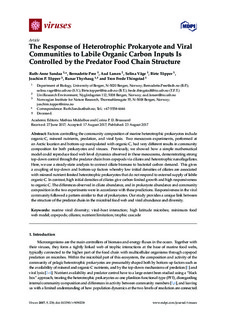| dc.contributor.author | Sandaa, Ruth-Anne | |
| dc.contributor.author | Pree, Bernadette | |
| dc.contributor.author | Larsen, Aud | |
| dc.contributor.author | Våge, Selina | |
| dc.contributor.author | Tøpper, Birte | |
| dc.contributor.author | Töpper, Joachim Paul | |
| dc.contributor.author | Thyrhaug, Runar | |
| dc.contributor.author | Thingstad, T. Frede | |
| dc.date.accessioned | 2017-09-08T09:00:59Z | |
| dc.date.available | 2017-09-08T09:00:59Z | |
| dc.date.created | 2017-08-29T12:48:46Z | |
| dc.date.issued | 2017 | |
| dc.identifier.issn | 1999-4915 | |
| dc.identifier.uri | http://hdl.handle.net/11250/2453709 | |
| dc.description.abstract | Factors controlling the community composition ofmarine heterotrophic prokaryotes include organic-C, mineral nutrients, predation, and viral lysis. Two mesocosm experiments, performed at an Arctic location and bottom-upmanipulated with organic-C, had very different results in community composition for both prokaryotes and viruses. Previously, we showed how a simple mathematical model could reproduce food web level dynamics observed in these mesocosms, demonstrating strong top-down control through the predator chain from copepods via ciliates and heterotrophic nanoflagellates. Here, we use a steady-state analysis to connect ciliate biomass to bacterial carbon demand. This gives a coupling of top-down and bottom-up factors whereby low initial densities of ciliates are associated withmineral nutrient-limited heterotrophic prokaryotes that do not respond to external supply of labile organic-C. In contrast, high initial densities of ciliates give carbon-limited growth and high responsiveness to organic-C. The differences observed in ciliate abundance, and in prokaryote abundance and community composition in the two experimentswere in accordancewith these predictions. Responsiveness in the viral community followed a pattern similar to that of prokaryotes. Our study provides a unique link between the structure of the predator chain in themicrobial food web and viral abundance and diversity. marine viral diversity; viral–host interaction; high latitude microbes; minimum food webmodel; copepods; ciliates; nutrient limitation; trophic cascade | nb_NO |
| dc.language.iso | eng | nb_NO |
| dc.rights | Navngivelse 4.0 Internasjonal | * |
| dc.rights.uri | http://creativecommons.org/licenses/by/4.0/deed.no | * |
| dc.subject | marine viral diversity | nb_NO |
| dc.subject | viral–host interaction | nb_NO |
| dc.subject | high latitude microbes | nb_NO |
| dc.subject | minimum food webmodel | nb_NO |
| dc.subject | copepods | nb_NO |
| dc.subject | ciliates | nb_NO |
| dc.subject | nutrient limitation | nb_NO |
| dc.subject | trophic cascade | nb_NO |
| dc.title | The Response of Heterotrophic Prokaryote and Viral Communities to Labile Organic Carbon Inputs Is Controlled by the Predator Food Chain Structure | nb_NO |
| dc.type | Journal article | nb_NO |
| dc.type | Peer reviewed | nb_NO |
| dc.description.version | publishedVersion | nb_NO |
| dc.subject.nsi | VDP::Zoologiske og botaniske fag: 480 | nb_NO |
| dc.subject.nsi | VDP::Zoology and botany: 480 | nb_NO |
| dc.source.volume | 9 | nb_NO |
| dc.source.journal | Viruses | nb_NO |
| dc.identifier.doi | 10.3390/v9090238 | |
| dc.identifier.cristin | 1489464 | |
| dc.relation.project | Norges forskningsråd: 175939 | nb_NO |
| dc.relation.project | Andre: European Research Council Advanced Grant ERC-AG-LS8 | nb_NO |
| dc.relation.project | Norges forskningsråd: 225956 | nb_NO |
| cristin.unitcode | 7511,8,0,0 | |
| cristin.unitname | Bergen | |
| cristin.ispublished | true | |
| cristin.fulltext | original | |
| cristin.qualitycode | 1 | |

